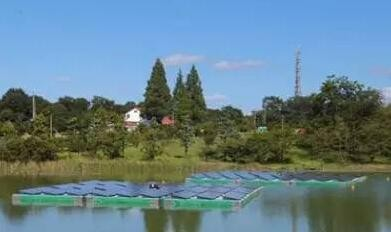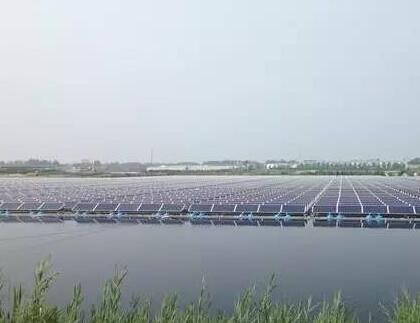In recent years, surface photovoltaic power generation, as a new form of photovoltaic power generation, has received widespread attention. Surface photovoltaic power stations refer to photovoltaic power stations built on water such as ponds, fish and crab ponds, lakes and water storage ponds, which have the advantages of not occupying land resources and can be absorbed nearby.
China is rich in water resources, and there are many lakes and reservoirs. The development of water photovoltaic power stations has the advantages of not occupying forest land and farmland resources, reducing water evaporation, and improving power generation through water surface reflection. By the end of 2012, there were 86000 reservoirs in China, with a total storage capacity of 6924 * 108 cubic meters, and a total water surface area of 25619 thousand hectares, or 38429 thousand mu (as of October 31, 1996). The total area of China’s lake resources is 91000 km2, and there are more than 2700 lakes with an area of more than 1000 square meters. There are sufficient conditions for the development of surface photovoltaic power stations, and there are prerequisites for the large-scale development of surface photovoltaic power stations.

This paper will analyze the advantages of water surface photovoltaic, the main technologies that affect water surface photovoltaic, and which technical features have little impact on water surface photovoltaic power generation through examples. Finally, it will introduce the key points of technical selection of main equipment of water surface photovoltaic.
Examples of surface photovoltaic
8MW floating photovoltaic system in the 30MW ground photovoltaic power station in Linxi County, Hebei Province.
The system uses the entire surface photovoltaic system of Jiangsu Langhe Nong Photopolymerization Technology Co., Ltd., with an installed capacity of 8MWP. The whole project adopts the 1MW integrated photovoltaic power station system solution, and adopts the block power generation, centralized grid connection and centralized control scheme. The system is divided into 8 grid-connected power generation units, which are connected to the photovoltaic power station after boosting by DC combiner box and inverter to finally realize grid connection. The support used in this project is floating on the water surface, which is fixed by the chain on the bank and is not affected by the water level. Therefore, it will not hinder the reservoir or affect its own power generation during the impoundment period and flood discharge period. In the project, both the angle of installing solar panels and the spacing of each row of floating island panels have fully considered the requirements of fishery and aquaculture, so as not to affect the growth of shrimp and fish in the reservoir. The project also specially adopts movable splicing components, which can move the area flexibly at any time, bringing more modes for fishery and aquaculture. The aquaculture mode of the reservoir adopts the combination of photovoltaic new energy and fishery aquaculture for comprehensive development, forming a power generation mode of “upper power generation and lower fish farming”, which realizes both fishery production increase and energy conservation and emission reduction.
Data analysis December 2015 Time: 29 days Test content: power station system design is consistent and close to inverter A (water surface): installed capacity: 660kW power generation: 475200 kWh B inverter (ground): installed capacity: 685kW power generation: 466200 kWh power generation increased by 5.8%! From April 2014 to March 2015, the Civil Affairs Bureau of Kitaomo, Hyogo Prefecture, Japan Rabbit shared the validation experiment on the floating photovoltaic power generation equipment with an output power of 40kW on the water surface of Jinggu Xinchi, Jinggu Town, Ono City. The project is mainly in the form of floating photovoltaic power generation, with 20kW (80 panels) power generation equipment installed in two ways respectively. The first is to moor the floating platform on the land with steel wire and set the battery panel at an angle of 10 degrees. The second is to moor the floating platform with a heavy object sunk to the bottom of the pool and set it at an angle of 20 degrees. A water sprayer is also set at the center of the floating platform to verify the water spraying effect.

Data analysis (1) In the comparison of power generation from the setting point of view, the power generation of battery panels at 10 degrees from May to August is higher, while the power generation of battery panels at 20 degrees in other months is higher. The results reflect the best inclination angle corresponding to the actual solar altitude angle in summer at the project site. (2) Different mooring methods have no significant difference in tracking, stability and power generation of strong wind and water level fluctuation. (3) Compared with the solar panels installed on the roof of the building at the same angle, the power generation increased by 14%. (4) In the comparison of power generation with or without water spraying, the 10-degree battery panel with water spraying had higher power generation on September 11 and 12 (5 hours from noon) of the experiment.
Water surface photovoltaic can significantly improve the power generation of photovoltaic power stations. From the above case analysis, it can be seen that water surface photovoltaic can significantly improve the power generation of photovoltaic power stations. The main reason can be attributed to the fact that the specific heat of water is much larger than that of land. Therefore, when the water and land receive the same solar heat, the temperature change of water body will be smaller than that of land, and the solar radiation can penetrate into the deeper water layer. The turbulent mixing effect of water body is strong, so that the solar radiation absorbed by water body is relatively evenly distributed at the upper and lower levels. This greatly mitigates the daily and monthly changes of temperature, making the summer temperature of the project site significantly lower than the land temperature. From the module voltage temperature coefficient, it can be clearly found that relatively low temperature can obtain more power generation.
Another factor that can affect power generation and is easy to be ignored is reflected radiation from water surface. We know that solar radiation can be divided into direct radiation and scattered radiation. These radiation will be reflected through the water surface and absorbed by solar panels for the second time. The amount of reflected radiation is determined by the reflectivity when the total solar radiation is certain. The greater the reflectivity, the greater the amount of reflected radiation.
Which technical features do not affect power generation
According to the above examples and the actual operation of other water surface photovoltaic power generation, the following technical features have little impact on the power generation, and cannot significantly improve or reduce the power generation level of the overall power station. Therefore, we only need to consider the system design from the perspective of convenient construction and economic benefits in combination with the actual situation:
The pile foundation form (pile type and floating type) of surface photovoltaic has little impact on the power generation.
Whether the optimal inclination angle is selected for water surface PV has little influence on power generation. Because combined with the actual situation of China, China’s aquatic PV is mainly concentrated in the central and eastern regions, the southern regions, the Huaihe River basin and other regions, and the optimal tilt angle is low. Compared with the pontoon tilt angle of about 25 ° and 12 °, the impact of the angle on the power generation of surface power stations is about 1.5%. However, the water surface area occupied by 25 ° PV tilt angle will increase.

Recommended components and inverters for main aquatic photovoltaic equipment
Double-glass modules stand out in the special environment of aquatic photovoltaic projects, which has strict requirements for photovoltaic modules. Double-glass modules made of glass materials become the best choice for aquatic photovoltaic by virtue of its moisture resistance, PID resistance and other characteristics. In IEC, PID and other key humidity observation test items, the power attenuation of the double-glass module is far less than that of the ordinary module. The back plate of the traditional module is made of organic composite material, which is easy to be eroded by natural environmental factors, while the back plate of the double-glass module is made of reinforced glass, which will not turn yellow under light irradiation, and the glass itself has high hardness, which is not easy to be worn by wind and sand, and will not be eroded by acid, alkali, salt, fog, water vapor and other factors, which is basically close to zero water permeability, without aluminum frame, PID resistance These characteristics of corrosion resistance make the double-glass module more compatible with the particularity of surface photovoltaic, and stand out from the competition with traditional modules.
The waterproof grade of the inverter should be IP65. For complex water conditions, higher IP67 protection grade is recommended.






